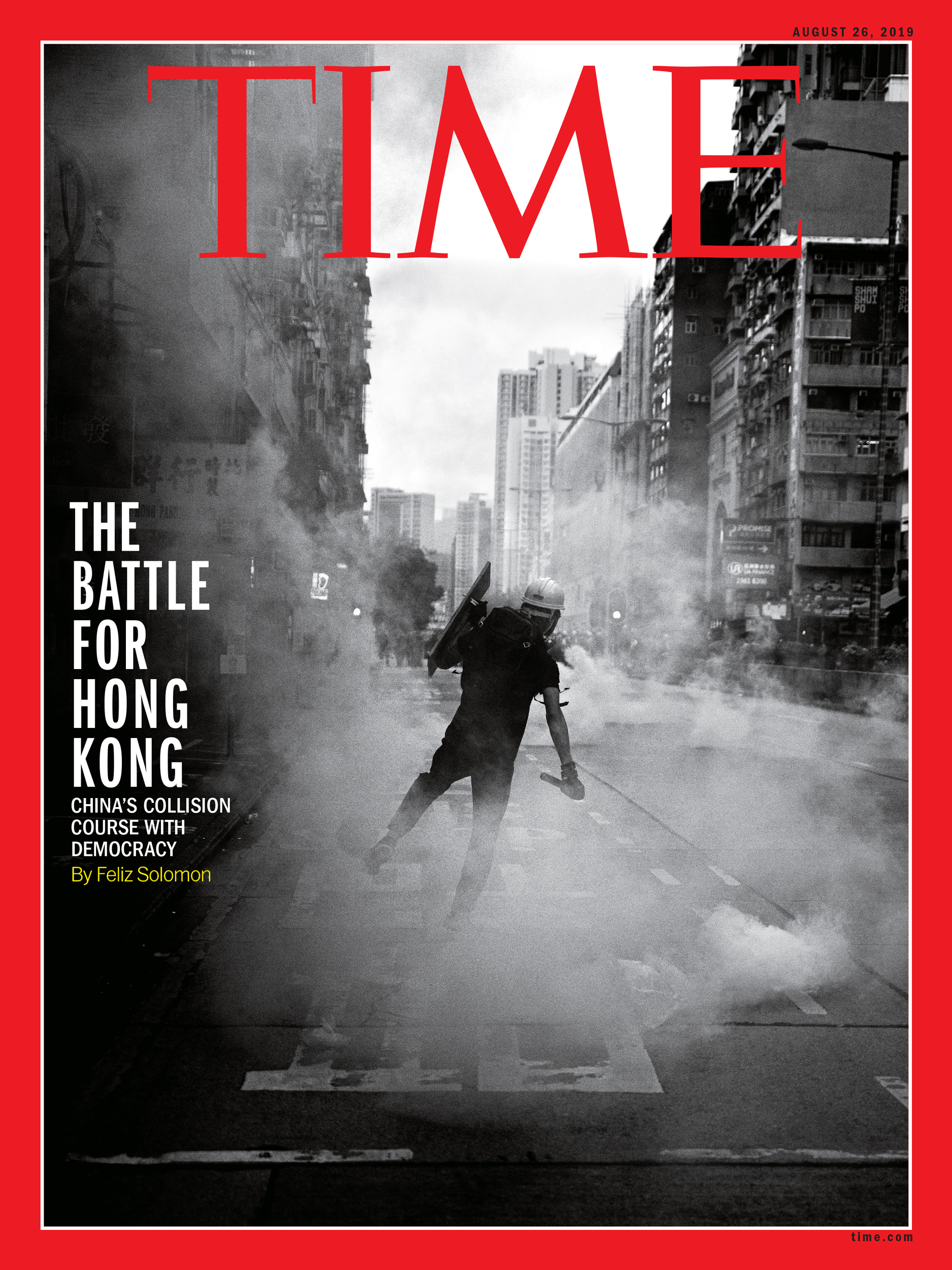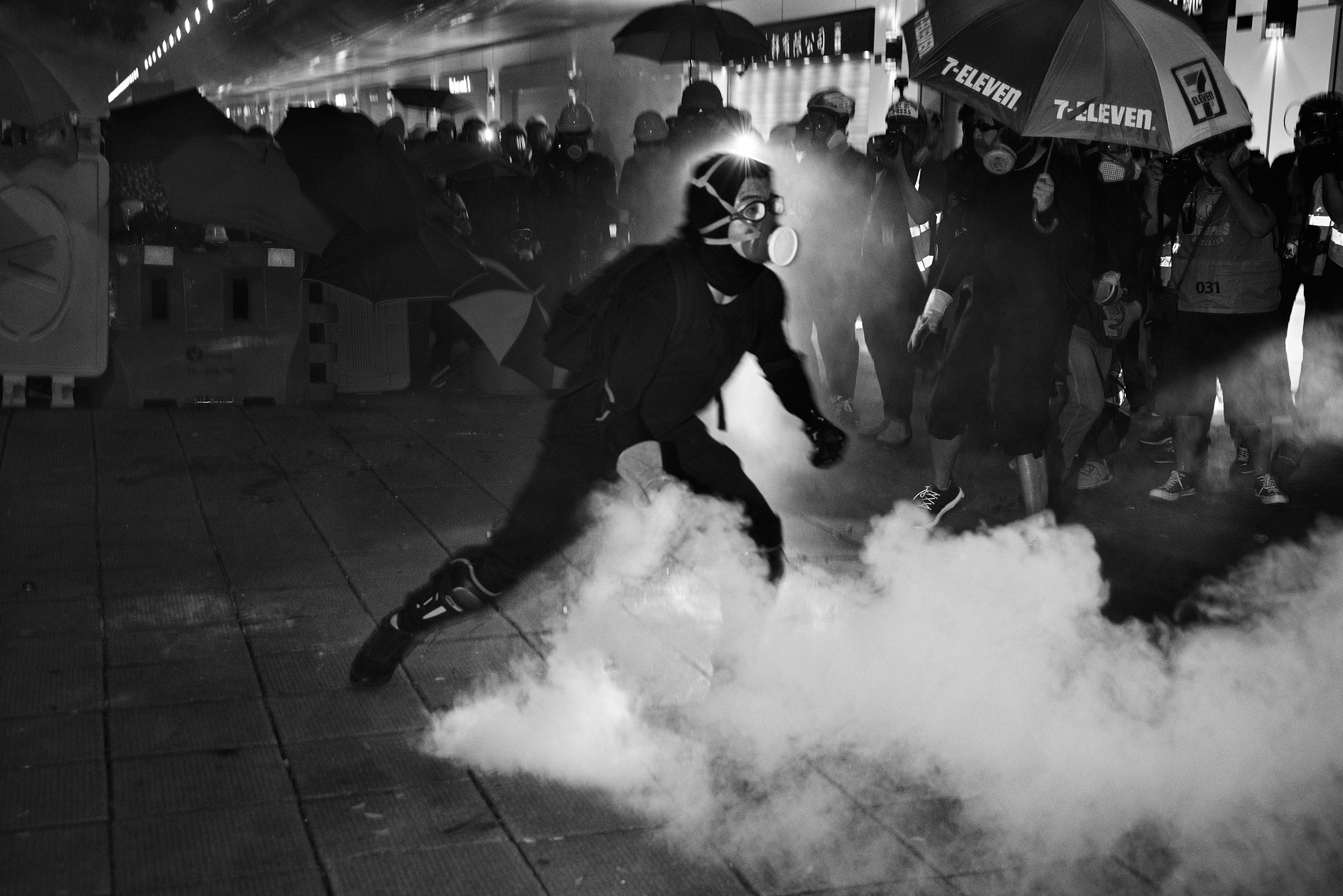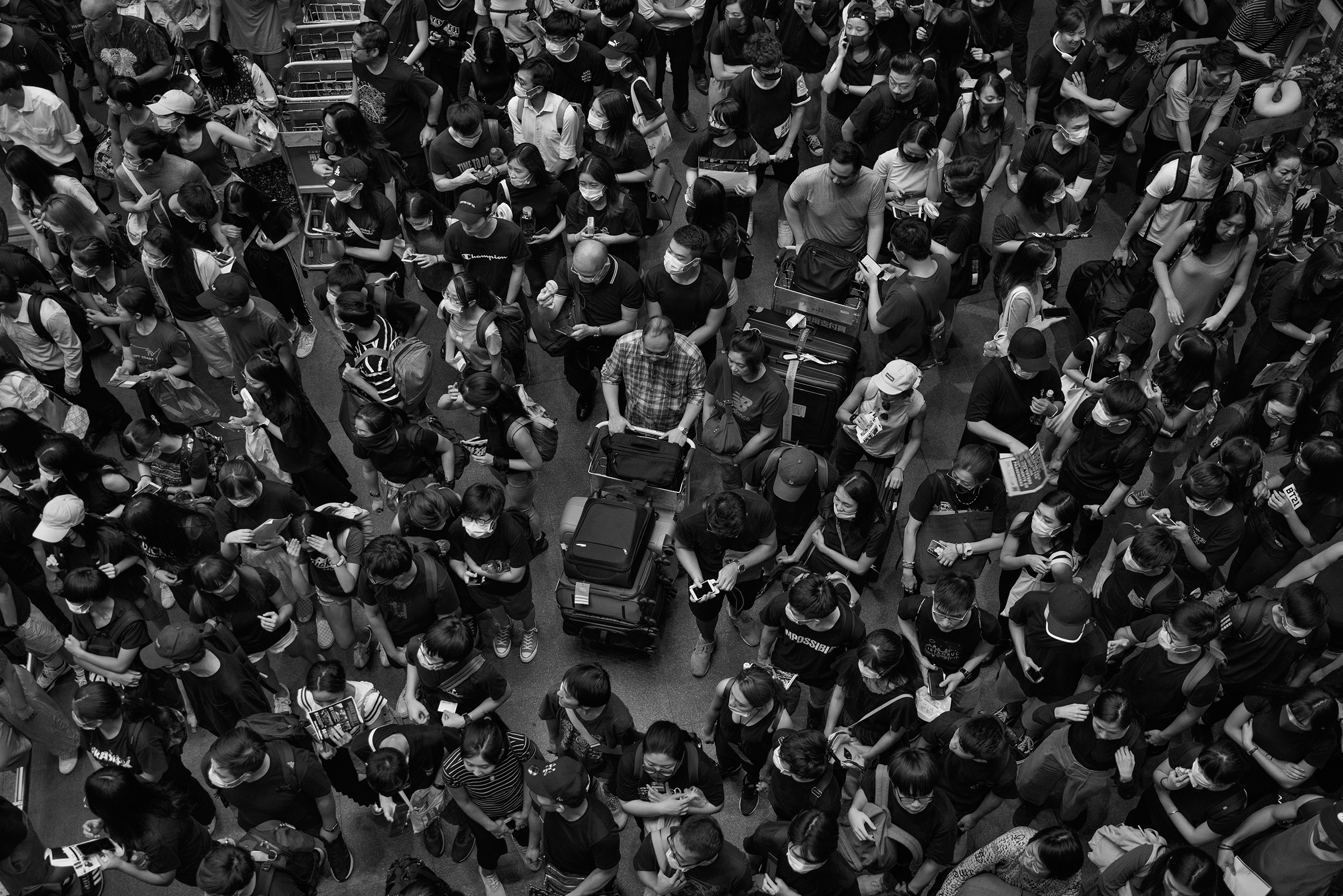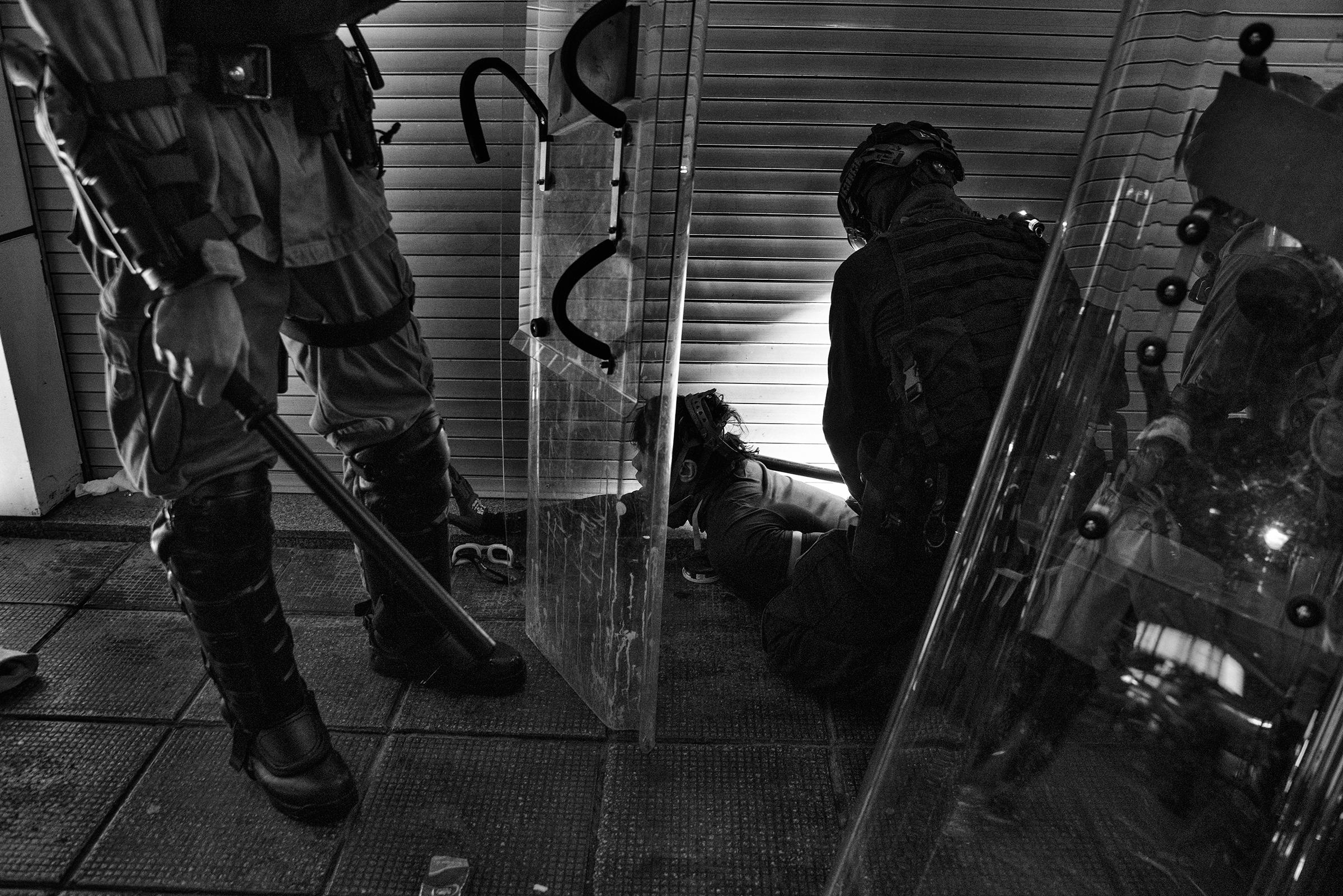How do you stop a city in its tracks? Anti-government protesters decided on Aug. 12 to strike at the epicenter of this ancient trading post, by bringing Hong Kong International Airport, one of the world’s busiest transit hubs, to a standstill. Hundreds of flights were canceled and countless travelers stranded in what appears to have been the largest-ever shutdown of a major airport.
The occupation came to a halt the following day in a brief surge of violence, as protesters turned on at least two people ostensibly within their ranks—detaining and injuring a reporter for a Chinese state-controlled newspaper and a man suspected of being an undercover Chinese officer disguised as an activist. Riot police stepped in to break up the fracas, this time without the tear gas and rubber bullets used freely in other skirmishes. One officer was caught on a cell-phone video drawing a handgun in the middle of a chaotic tussle, but did not fire.
The tension in that scene defines the battle for Hong Kong midway through its third month. The city’s embattled leader, Chief Executive Carrie Lam, warned earlier that the protests risk pushing Hong Kong further “into an abyss,” as fears began to spread that Chinese law enforcement might intervene. Joining the hum of paranoia rippling across social media, U.S. President Donald Trump said he had received intelligence that troops were massing at the border. Before sharing undated footage of what appeared to be Chinese military vehicles in transit, the President tweeted: “Everyone should be calm and safe!”

There is no longer any doubt that Hong Kong is on a collision course with the Chinese government, which has ruled the former British colony since 1997. What began as an uprising against a single piece of legislation has spiraled into all-out rebellion against Beijing’s encroaching authoritarianism, and a demand for more democracy. Peaceful processions have morphed into pitched battles on the dense residential streets. Lam and her largely pro-Beijing government have all but vanished, hiding behind columns of anonymous riot police and making occasional, highly scripted remarks to the press. The increasingly radical nature of the protests has not, as authorities expected, diminished their popular support. But the demonstrators are nonetheless bracing for a lethal blow as the government’s patience wears thin.
Long before the city streets became a battleground, China had already begun waging a war for Hong Kong’s soul. Under President Xi Jinping, the Communist Party has quietly used its levers of social control on the freest courts, schools, media and economy on Chinese soil. “Just as he’s cracked down on any signs of dissidence in mainland China,” says Chris Patten, the last British governor of Hong Kong, there has been a “whittling away of free speech, the autonomy of universities, an undermining of the rule of law, and that’s increased people’s anxieties.”
Hong Kong’s populace recognizes that the city’s unique character and freedoms are ebbing away—and many are willing to make sacrifices to defend them. With arrests on the rise, they risk their liberty attending marches that authorities have started to label “unlawful.” They risk the city’s status as a financial portal, as the unrest begins to take a toll on the economy. The fear now is that some may even sacrifice their lives as China decides how to bring this summer of demonstrations to an end. “I don’t really see a way out,” says political analyst Sonny Lo. “We’re just hoping the situation won’t deteriorate.”
The anniversary of Hong Kong’s handover to Chinese sovereignty, July 1, marked a turning point in the crisis, when anger shifted directly to symbols of Beijing’s rule. Brian Leung Kai-ping doesn’t regret what he did that night, but he knows it will cost him. The 25-year-old student was among the scrum of demonstrators who forced their way into the city’s legislature, known as LegCo. Having shattered glass walls with a battering ram, they climbed up an idle escalator; felt their way through unlit corridors; and pried open doors before spilling onto the chamber floor in their uniform of black T-shirts, dust masks, hard hats and goggles. “That moment was so powerful,” says Leung. “The root cause of our problem was right there in that chamber.”
A scene of anarchy ensued as protesters ransacked government offices, defaced portraits of the city’s leaders, and spray-painted slogans on walls and furniture like “Hong Kong is not China, not yet.” Not knowing what to do next, confused-looking kids milled around in what by then resembled a disaster zone. “At that moment, I chose to step up and take off my mask,” Leung says. He crawled on top of a lawmaker’s desk, tore off his respirator and shouted, “We are at the point of no return!”
How Hong Kong arrived at that moment is a tale of promises slowly coming undone. When the territory was returned to Chinese sovereignty in 1997 under an agreement called “one country, two systems,” it was guaranteed a high degree of autonomy meant to safeguard its way of life for 50 years. This craggy outpost on the South China Sea, home to 7.3 million people, is known as “Asia’s World City” because of its cosmopolitan nature. At the time a capitalist enclave in a communist empire, the regional finance hub once served as the conduit for almost all commerce between East and West. Its clean governance, independent judiciary, freedoms of religion, expression and assembly—all but vanished on the mainland—are cherished by its citizens.
Over the past 22 years, Hong Kongers have periodically mounted the barricades to defend their city’s essential spirit. In 2003, an estimated half-million people took to the streets and successfully stymied a national-security bill outlawing sedition and treason. In 2012, a student protest movement led by then 15-year-old activist Joshua Wong scuttled Beijing’s efforts to impose a “patriotic” school curriculum broadly viewed as brainwashing. Two years later, not long after Xi came to power, the Umbrella Movement brought their fight to the world’s attention. The 79-day occupation of a busy commercial district was sparked by outrage over images of police blasting pepper spray at student protesters, again led by Wong, who had reclaimed a public square fenced off by the government.

The sight of kids screaming in pain and being dragged away by officers in riot gear moved tens of thousands of people to join a march, planned earlier by more established pro-democracy figures, against a proposal by Beijing to vet candidates for the city’s chief executive role. The battle was ultimately lost, and colorful tent cities were slowly demolished amid dwindling public support.
The crackdown came later, in the form of death by a thousand cuts. The disappearance of five booksellers in 2015, known for peddling salacious texts about the Communist Party, sounded the first alarm. Several young activists elected to public office the following year were disqualified because the way they said their oaths was deemed “insincere.” (Some refused to pledge allegiance to China and used offensive language.) Not long after that, ringleaders of the protests—including Wong—were dealt prison sentences and labeled internationally as Hong Kong’s first prisoners of conscience. In retrospect, there’s a sense among the city’s democrats that the kids were right all along, but that not enough people believed them when they warned of a slide toward authoritarianism.
Since then, the erosion of the city’s freedoms has sped up. Members of the pro–democratic camp have warned of the patient and insidious takeover of political mechanisms by the United Front, a coalition of political parties tasked with exporting the Communist Party’s agenda. Trade unions and influential professional associations are stacked with Beijing-friendly executives, often through coercive methods. Mainland conglomerates have bought up publishing houses and distributors, choking out banned content that used to be freely available in bookshops at the airport and throughout the city.
In September 2018, a political party that advocated for independence, the Hong Kong National Party, was banned and a Financial Times journalist denied a visa after appearing at a press club event with its leader.
“There was never before this sense that there were sensitive topics you couldn’t talk about publicly, or write freely and publish about,” says Antony Dapiran, a lawyer and author of the book City of Protest: A Recent History of Dissent in Hong Kong. Only a few years ago, he says, “even open criticism of the central government was considered fair game.”
Fears exploded into public view on June 9, when an estimated 1 million people joined the first in a series of protests against a bill that would allow the extradition of fugitives to the mainland, where justice is notoriously opaque. Within a week, public outcry forced the government to suspend the legislation. But Lam’s refusal to fully withdraw it, coupled with allegations of police brutality, triggered an even bigger outburst; organizers say some 2 million people marched the very next day.

Then came July 1 and the act of resistance that heralded a weekly routine of worsening unrest. The peaceful marches now typically descend into violence by nightfall, when authorities arrive. A few of the more radical demonstrators have started fires in front of police buildings, thrown bricks at officers and into their homes, and launched projectiles like Molotov cocktails and handcrafted spears. Increasingly, protesters have come under attack by mobs carrying sticks and other weapons, believed to be hired thugs associated with triads, or criminal gangs. Police, who are not required to wear identification on the premise that a few were unmasked and harassed on the Internet, have been documented using excessive force against mostly peaceful protesters.
Inside the glass skyscrapers that cluster the Hong Kong skyline, the business community is hoping the city’s financial integrity won’t suffer from this summer of discontent. But a drop in tourism has already done considerable damage to luxury retailers and the service industry, while uncertainty over political instability—compounded by the U.S.-China trade war—has some investors spooked. The Hong Kong Stock Exchange, one of the largest in the world, has dropped to its lowest point since January on major indexes. Tara Joseph, president of the American Chamber of Commerce in Hong Kong, called on the government to do more to maintain investor confidence: “The next two months are absolutely crucial and could be make or break for Hong Kong.”
Hong Kong’s moderates, meanwhile, have pleaded with the protesters to temper their activity, advocating for a gradual adjustment to the inevitability of Chinese authority. “We have to look at Hong Kong as a part of the People’s Republic of China, which happens to be governed by the Communist Party,” says Christine Loh, a former legislator and Under Secretary for the Environment. “That’s a reality check that many people seem not to want to deal with.”
Authorities initially appeared to be waiting out the protests in hopes they would lose momentum. But each week is now bookended by more violent clashes. Hundreds of activists have been arrested and scores charged with rioting, which carries a sentence of up to 10 years in prison. Farcical amounts of tear gas—nearly 2,000 rounds over the course of a few weeks—have been deployed as authorities test more hazardous weapons like water cannons. “It’s like they’re using more crazy methods just to make us stop,” a 21-year-old protester, using the nickname Kevin, tells TIME on a downtown street still clouded with the nauseating smoke. “That’s what they do in China, they’ll do anything to make you shut up.”
Leung is no longer with them. Six weeks after his face was captured on camera calling for an occupation, he has left the territory and doesn’t know if he’ll ever come back. “My utmost intention is to finish my studies, go back and contribute to Hong Kong,” he says. “That is my hope, but I have to consider my options.”
If the view from Hong Kong is one of impending doom, the view from mainland China has been one of irritation. China is a nation of 1.4 billion people, and Hong Kong no longer a key portal. Its residents are seen as spoiled and disloyal, the problem as distant and isolated. Beijing is seasoned in dealing with what it sees as “troublemakers” agitating for democratic change, discrediting opposition and leveraging nationalist sentiment to vilify them as enemies of the state. As happened to the Buddhist leader of Tibet, the Communist Party has tried to make interacting with Joshua Wong “toxic” in other countries, according to Jeffrey Wasserstrom, a historian of modern China at the University of California, Irvine. “That’s right out of the international playbook that Beijing has used with the Dalai Lama,” he says.
Yet the signs of Beijing’s growing impatience are hard to miss. Having initially blacked out news of the protests, China is now spreading misinformation freely. Manipulated images disseminated through state-controlled press and on strictly censored domestic social-media platforms like Weibo portray the protesters as violent rioters. The Chinese government has also cast the crisis as a product of meddlesome “foreign forces,” claiming the U.S. conspired with “secessionists” to undermine the state.
In mid-August, warnings from the mainland became more severe. The Chinese government’s top official in Hong Kong, Yang Guang, warned that the unrest has “started to show signs of terrorism.” If disruptions continue to escalate, the Hong Kong government, which by design is Beijing-approved, can call on the People’s Liberation Army to help maintain “public order”; China has as many as 10,000 troops permanently garrisoned on Hong Kong Island, while satellite imagery appears to show military vehicles amassed at a sports complex in Shenzhen. Rumors of police speaking Mandarin, instead of the Cantonese more common in Hong Kong, fuel speculation that the dam has already been breached.
The crisis has become a test of Xi’s willingness to show restraint and abide by global norms. What is unfolding in Hong Kong is the largest, most visible repudiation of Beijing since the pro-democracy rallies at Tiananmen Square in 1989, which ended in a state-sanctioned massacre of unarmed activists. Few believe a repeat of that event is likely; slow economic growth and a bruising trade war could give Beijing pause before creating a similar spectacle that, even amid a fractured global order, might launch it back into pariah status.

But a less bloody crackdown might still be an option. Xi will have weighed the limp international response to China’s treatment of Uighur and other Muslim minorities in the western province of Xinjiang, where more than a million are believed to be detained in concentration camps. U.S. officials say they would not expect a strong response from the White House in the event of a violent confrontation. Sources close to the Administration say the risk of intervention by Chinese paramilitary police, possibly even the army, has risen significantly in recent days, but there has been no substantive discussion about how Washington might respond.
Trump has so far taken a hands-off approach, refusing to criticize Beijing while in the midst of trade negotiations. “I hope it works out for everybody including China,” he told reporters on Aug. 13. “I hope it works out peacefully, nobody gets hurt, nobody gets killed.” Lawmakers across the political spectrum, including Democratic presidential hopeful Senator Elizabeth Warren and Republican Senator Marco Rubio, have more vocally backed the protesters, in keeping with the long-standing tradition of U.S. support for democratic movements and autonomy in the territory.
The city’s attempt to resist Xi’s project should sound a bellwether for the wider world, pro-democracy figures say. “Hong Kong is the only place in China that is still capable of speaking out against Beijing, and the world should really think about our value as a check on China’s power,” says Bonnie Leung Wing-man, a district councillor who, as a leader of a pro-democratic coalition called the Civil Human Rights Front, has been at the forefront of the protests since they began. “When you do business with China, when you sign a contract with them, can you trust their terms?”
For Hong Kong’s youth, in particular, trust seems more distant than ever before. Lam’s stubborn retreat from the public has pushed her deeper into Beijing’s corner. Each new confrontation drives the wedge further between the government and its critics, and there’s a growing sense the gap is now too wide to bridge. “This is our last resort,” says Sav, 24, by day a student pilot and by night a masked activist. The airport is her home away from home, but she supports the occupation of the transit hub. “If the government doesn’t want to protect Hong Kong, then why are they even here?” she asks, rattling off a list of officials she wants to see resign. “I don’t think this will end easily.”
With additional reporting by Amy Gunia / Hong Kong, Charlie Campbell / Shanghai, Madeline Roache / London and John Walcott / Washington
More Must-Reads from TIME
- Cybersecurity Experts Are Sounding the Alarm on DOGE
- Meet the 2025 Women of the Year
- The Harsh Truth About Disability Inclusion
- Why Do More Young Adults Have Cancer?
- Colman Domingo Leads With Radical Love
- How to Get Better at Doing Things Alone
- Michelle Zauner Stares Down the Darkness
Contact us at letters@time.com